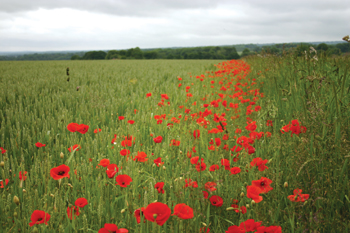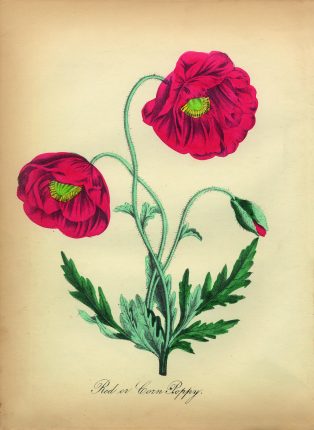Martyn Baguley helps us to understand the plant that has alleviated suffering on the battlefield but also caused untold misery
If any plant can be called enigmatic it must be the opium poppy, for it has been both a blessing and curse to mankind.Native to a region that ranges from Turkey east to Afghanistan, India, Myanmar and Thailand, for centuries the disarmingly pretty plant decorated gardens of the wealthy and was used as part of floral decorations.
Papaver somniferum (‘Papaver’ the poppy genus; ‘somniferum’ after Somnus, the Roman god of sleep) grows quickly up to a height of one metre. As a blessing it is the source of the painkiller morphine; as a curse, one of its derivatives, heroin, has had catastrophic effects on mankind worldwide. The poppy also has the unenviable reputation (correct me if I’m wrong) of being the only plant to cause a war.

Said to have been exploited by mankind for at least 6,000 years, the earliest reference to the plant being cultivated is in 3,400BC in south-west Asia, where the Sumerians called it hul gil, the ‘joy plant’. With such a reputation it isn’t surprising that people began to cultivate it to increase availability and reduce the cost, and it soon found its way along the Silk Road, west to the Mediterranean and east to China.
For centuries what was commonly called ‘milk of the poppy’ (now called opium) was prescribed for almost every ailment. The name aptly describes the milk-like latex found in the capsules enclosing the seeds of the plant from which, when dried, morphine, codeine and heroin are derived. The name ‘opium’ comes from the ancient Greek name for the sap: opion.
Poppy pain relief
My quest to find out how and why Papaver somniferum got its pain-relieving properties led me down a lot of blind alleys until I discovered that a team of researchers has been studying the subject for several years.
By chance, over millions of years it seems that the genetic composition of Papaver somniferum plants underwent several mutations. One or more of these created a gene that produces an enzyme that converts molecules into compounds that eventually become morphine and codeine. Without that gene, Papaver somniferum wouldn’t have pain-killing properties; in fact, many varieties of poppy have little or none.
Charles Darwin’s ‘survival of the fittest’ theory perhaps provides the answer to ‘why’ the mutations occurred. Herbivorous animals, sleeping or dozy after munching poppy plants, are more vulnerable than alert animals to carnivorous predators. So natural selection favoured animals that didn’t browse on poppy plants – and the plants evolved a defence system against browsing herbivores.
Morphine discovered in poppies
In 1805, German pharmacist Friedrich Sertürner discovered morphine while working as an assistant in a pharmacy in Germany. He named the substance he had isolated ‘morphine’ after Morpheus, the ancient Greek god of sleep and dreams, and to prove that it was the active ingredient in opium he publicly experimented on himself and three friends. When convinced, physicians called it ‘God’s own medicine’ because of its reliability, long-lasting effects and safety.
Ironically, in a quest to find a non-addictive alternative to morphine, Charles Wright, a chemistry lecturer in London, isolated the seriously addictive diamorphine in 1874. In 1898, the German company Bayer began manufacturing it as a non-addictive pain medication under the brand name ‘heroin’ (possibly derived from the ancient Greek word for a hero: people who took the drug said they felt heroic). When its addictive potential was recognised the drug’s production was stopped in 1913.
In the early 1800s, British traders introduced opium into China from British-owned Bengal. They weren’t the first to do so – Turkish and Arab traders had prevously introduced the drug into China in the late 1500s.

Until the 17th century it had been used in relatively small quantities to relieve pain. Then tobacco began to be imported into China and pipe smoking became popular. By 1729, opium smoking had become such a problem that the emperor prohibited its import and the smoking of it. Despite the decree the opium trade continued to flourish. By 1773, the British had become the leading supplier of opium to China and by 1793 the British East India Company had established a monopoly on the opium trade, with poppy growers in India forbidden to sell to competitors.
Soaring opium addiction rates in China led to two so-called ‘Opium Wars’ in the mid 19th century, both of which China lost, forcing the opening of Chinese ports to western traders and eventually the concession of Hong Kong to Britain.
Opium imports continued to increase after the wars and, unsurprisingly, with the predominantly peasant farmer population largely debilitated by both famine and opium addiction, this led to a revolution. Privately owned land was seized by the people and given to communities; Mao Zedong rose to become Communist leader in 1949 and went on to instigate the so-called ‘Cultural Revolution’ from 1966 until his death in 1976. According to some commentators, the revolution paralysed China politically, damaged the economy and society, and caused the death of possibly as many as two million people. However, Zedong’s government is credited with the ruthless eradication of both the consumption of opium and the production of opium poppies.
William Gladstone, British prime minister from 1892 to 1894, strongly opposed the British action in Parliament at the time, and wrote: “I am in dread of the judgements of God upon England for our national iniquity towards China.”
Monet and Van Gogh couldn’t resist painting poppies and poets have waxed lyrical about them, so it would be remiss of me not to give some space to one of the opium poppy’s cousins, which will enjoy a high profile this month: Papaver rhoeas (‘rhoeas’ is the Greek word for red). It goes by many names: common, field and Shirley poppy, corn rose, red weal and others – but we know it best as the Flanders poppy because, growing from seeds that can remain dormant for 100 years, they were the first flowers to appear in the blitzed ground of Flanders during World War I.
Within living memory, blood-red poppies adorned Britain’s farmland during the summer months. Having long been associated with mankind it is not surprising that it has established a firm place in folklore. It was called the ‘thunder-flower’ and children were told that if a petal fell off the flower when it was picked the gatherer could be struck by lightning. It was also variously claimed that if a flower were held too near an eye it would cause blindness, too near an ear would cause earache and, if smelled, nosebleeds would follow that could only be stopped by pushing a cobweb up the nostrils.
All nonsense, but not without purpose; it may not produce opium but it does contain an alkaloid called rhoeadine, which is a mild sedative. The pretty red flowers must have tempted children to pick them. The prospect of being struck by lightning, becoming blind, having nosebleeds or earache would have been good deterrents.
On 2 May 1915 during the bloody second battle of Ypres, 22-year-old Lieutenant Alexis Heimer was killed by an enemy shell. His death was witnessed by a close friend, 42-year-old Canadian Major John McCrae, who, with no chaplain available, performed funeral rites the next morning. The stories of what followed are many and varied, but there is no doubt that McCrae was so moved by his friend’s death that, motivated by the simple wooden crosses and clusters of field poppies that marked the improvised graveyard, he scribbled a poem that started:
In Flanders Fields the poppies blow
Between the crosses, row on row.
That mark the place; and in the sky
The larks, still bravely singing, fly
Scarce heard amid the guns below.

In Flanders Fields the poppies blow
The three-stanza poem was saved from being lost to posterity by a fellow officer, who stopped McCrae from destroying it. McCrae eventually sent it to Punch magazine where, during December 1915, it was published in the bottom corner of an inside page with no attribution. Sadly, John McCrae didn’t survive the war, dying from pneumonia during January 1918. He was never to know what a profound influence his words would have on posterity.
The story now travels to the city of New York where, on 9 November 1918, two days before the Armistice, 47-year-old Professor Moina Michael was attending a YMCA conference. On her desk lay a copy of the American Ladies’ Home Journal. Browsing through it she came across a copy of McCrae’s poem. It wasn’t the first time she had seen it but this time the words had such a profound effect that she picked up an envelope and started scribbling:
We cherish, too, the poppy red
That grows on fields where valor led…
She titled her poem We Shall Keep The Faith and pledged that from that moment she would always wear a red poppy.
Fired by her commitment, Moina Michael scoured the local shops until she found one large and 24 small, silk poppies resembling the wild poppies of Flanders. The conference’s male delegates were so impressed when they saw her wearing one pinned on her coat they asked if she had any more. The remaining 24 poppies were duly distributed around the group: it was the first occasion when poppies were worn in memory of soldiers who had died in battle.
Michael’s tireless campaign over the following years to make the poppy a national remembrance symbol earned her the title ‘The Poppy Lady’, and the money raised every year from the sale of Remembrance Day poppies continues to help veterans from all wars.




